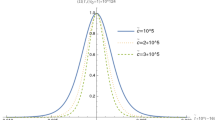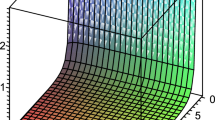Abstract
Based on Khalatnikov’s ideas, we consider the physical processes that arise in the collapse of wormholes of different types. We emphasize that the physical processes during the collapse and their outcome depend significantly on the type of wormhole. We consider in detail how black holes arise in the collapse of wormholes.









Similar content being viewed by others
Notes
We used the scalar fields, because they could be spherically symmetric and, at the same time, be radiated.
This term was introduced in [6] to denote the WHs whose tunnels are oriented in the time direction.
In the Penrose–Carter diagram infinitely remote points and regions are transferred to finite distances using a coordinate transformation. For example, in Fig. 5, I0 is the spatial infinity, I+ and I– are the temporal infinities.
Recall that we consider spherically symmetric models and Fig. 5 displays the radial structure of the models. They should be topologically multiplied by the angular part. Thus, the r+, 1, r–, and other lines are two-dimensional surfaces.
REFERENCES
E. M. Lifshits and I. M. Khalatnikov, Sov. Phys. Usp. 6, 495 (1963).
E. M. Lifshits and I. M. Khalatnikov, Adv. Phys. 12, 185 (1965).
V. A. Belinskii, E. M. Lifshits, and I. M. Khalatnikov, Sov. Phys. JETP 35, 838 (1972).
I. Flamm, Phys. Z. 17, 448 (1916).
M. Visser, Lorentzian Wormholes: From Einstein to Hawking (AIP, Woodbury, 1995; Springer, 1996).
I. D. Novikov, Phys. Usp. 61, 692 (2018).
J. L. Friedman, K. Schleich, and D. M. Witt, Phys. Rev. Lett. 71, 1486 (1993).
I. D. Novikov, N. S. Kardashev, and A. A. Shatskii, Phys. Usp. 50, 965 (2007).
C. Armendariz-Picon, Phys. Rev. D 65, 104010 (2002).
J. Ellis, Math. Phys. 14, 104 (1973).
K. A. Bronnikov, Acta Phys. Polon. B 4, 251 (1973).
M. S. Morris and K. S. Thorne, Am. J. Phys. 56, 395 (1989).
J. A. Gonzalez, F. S. Guzman, and O. Sarbach, Class. Quant. Grav. 26, 015010 (2009).
K. A. Bronnikov, L. N. Lipatova, I. D. Novikov, and A. A. Shatskiy, Grav. Cosmol. 19, 269 (2013).
I. D. Novikov and A. A. Shatskiy, J. Exp. Theor. Phys. 114, 801 (2012).
D. I. Novikov, A. G. Doroshkevich, I. D. Novikov, and A. A. Shatskii, Astron. Rep. 53, 1079 (2009).
Shinkai Hisan-aki and S. A. Hayward, Phys. Rev. D 66, 044005 (2002).
J. A. Gonzalez, F. S. Guzman, and O. Sarbach, Class. Quant. Grav. 26, 015011 (2009).
A. Doroshkevich, J. Hansen, I. Novikov, and A. Shatskiy, Int. J. Mod. Phys. 18, 1665 (2009).
A. Doroshkevich, J. Hansen, D. Novikov, I. Novikov, Dong-Ho Park, and A. Shatskiy, Phys. Rev. D 81, 124011 (2010).
I. Hansen, A. Khokhlov, and I. Novikov, Phys. Rev. D 71, 0064013 (2005).
A. A. Shatskii, I. D. Novikov, and N. S. Kardashev, Phys. Usp. 51, 457 (2008).
L. D. Landau and E. M. Lifshitz, Course of Theoretical Physics, Vol. 2: The Classical Theory of Fields (Nauka, Moscow, 1988; Pergamon, Oxford, 1975).
E. Novikova and I. Novikov, Phys. Rev. D 81, 104034 (2010).
E. Kazner, Am. J. Math. 43, 217 (1921).
G. Rozen, Phys. Rev. 136, 2798 (1964).
Ya. B. Zeldovich and I. D. Novikov, Relativistic Astrophysics, Vol. 2: The Structure and Evolution of the Universe (Nauka, Moscow, 1975; Univ. of Chicago Press, Chicago, 1983).
Ya. B. Zeldovich and I. D. Novikov, Relativistic Astrophysics (Nauka, Moscow, 1967; Univ. of Chicago Press, Chicago, 1971).
I. D. Novikov, JETP Lett. 3, 142 (1966).
I. D. Novikov, Sov. Astron. 10, 731 (1966).
V. Frolov and I. Novikov, Black Hole Physics (Kluwer Academic, Dordrecht, 1998).
A. G. Doroshkevich and I. D. Novikov, Sov. Astron. 14, 673 (1970).
ACKNOWLEDGMENTS
We thank S. Repin for the discussion and help.
Funding
This work was supported by Program no. 12 of the Presidium of the Russian Academy of Sciences “Problems of the Origin and Evolution of the Universe.”
Author information
Authors and Affiliations
Corresponding author
Additional information
Contribution for the JETP special issue in honor of I. M. Khalatnikov’s 100th anniversary
Translated by V. Astakhov
Rights and permissions
About this article
Cite this article
Novikov, I.D., Novikov, D.I. Collapse of a Wormhole and Its Transformation into Black Holes. J. Exp. Theor. Phys. 129, 495–502 (2019). https://doi.org/10.1134/S1063776119100248
Received:
Revised:
Accepted:
Published:
Issue Date:
DOI: https://doi.org/10.1134/S1063776119100248




